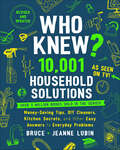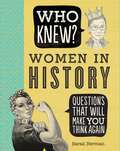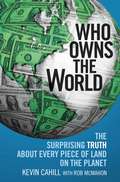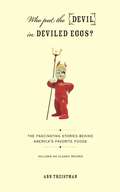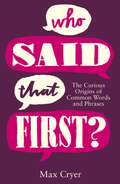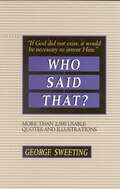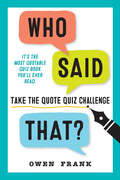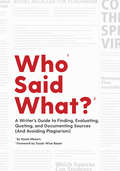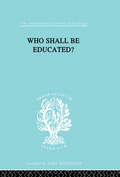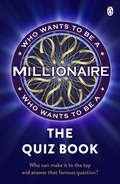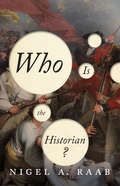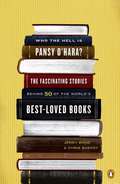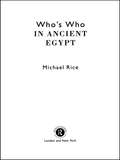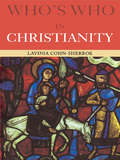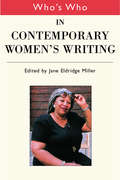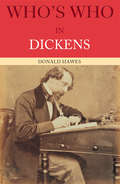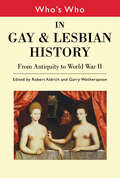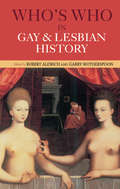- Table View
- List View
Who Knew? 10,001 Household Solutions: Money-Saving Tips, DIY Cleaners, Kitchen Secrets, and Other Easy Answers to Everyday Problems
by Bruce Lubin Jeanne LubinA big new book on household solutions from the 5-million-copy-selling Who Knew? brand!Whether you’re cleaning house, cooking a meal, improving your appearance, or fighting a cold, this indispensable guide will help you with natural and simple solutions to your daily tasks requiring only basic—and inexpensive—items with multiple uses that you should always keep on hand in your home.Vinegar, baking soda, lemons, duct tape, and beer are just a few of the all-purpose tools you need to eliminate odors, keep your food fresher longer, get rid of pests, increase storage space, de-stress, give yourself a spa treatment, and so much more. With easy-to-follow instructions, you’ll discover clever and creative ways to give your home—and yourself—a makeover while saving time and money.
Who Knew? Women in History (Who Knew?)
by Sarah HermanBrush up on your knowledge of prominent women through the ages, from across the globe, and in all walks of life.Who Knew? Women in History is a compendium of more than a hundred articles about women who have played a prominent role in world history. After reading this book, you’ll be the center of attention at any party or around the water cooler as you spout forth impressive answers to questions such as: What made Catherine the Great so great? Who was the “Mother of the Atom Bomb”? Where in the world did women first gain the right to vote? Each chapter includes a quiz at the end to test your knowledge. These tidbits of trivia will leave everyone shaking their head and saying “Who knew?” The answer to that question, of course, will be: You knew!
Who Knew?: Green Hints and Tips to Save Time, Money... And the Planet
by Jeanne Bossolina LubinWho Knew?: You can save 40% on the cost of air conditioning, that bottled water creates over 1.5 million tons of plastic waste a year, turning off your car's air conditioner can improve your fuel economy by more than 20%... and much more.
Who Knew?: Questions That Will Make You Think Again (Who Knew? Ser.)
by Sarah HermanTrivia that will make you ask, "Who knew?"Why do elephants have such big ears? What's the difference between fog and mist? Who invented sliced bread? Be the smartest slacker in the break room, the brainiest guest at the wedding, and the cleverest cat at the cocktail party. Whether you're trying to impress your friends, or simply in need of a knowledge fix, Who Knew? is the book for you. Filled with gems of wisdom to dazzle your brain cells, there are plenty of tales to surprise and delight even the most ardent trivia fan. From the plagues of the Middle Ages and the rules of Roman architecture to culinary customs, presidential assassinations, and the contents of James Bond's glass; we cover it all. With a clever quiz at the end of each chapter, you'll be ready for mastermind status in no time. Galvanize your grey matter with this classic compendium as you find yourself asking, "Who knew?"
Who Owns the World: The Surprising Truth About Every Piece of Land on the Planet
by Kevin Cahill Rob McMahonYou don't have to be a student of geography or cartography to have an interest in the world around you, especially with globalization making our planet seem smaller than ever. Now you can IM someone in Alaska, purchase coffee beans from Timor-Leste, and visit Dubai. But what do we really know about these lands? WHO OWNS THE WORLD presents the results of the first-ever landownership survey of all 197 states and 66 territories of the world, and reveals facts both startling and eye-opening. You'll learn that: --Only 15% of the world's population lays claim to landownership, and that landownership in too few hands is probably the single greatest cause of poverty. --Queen Elizabeth II owns 1/6 of the entire land surface on earth (nearly 3 times the size of the U.S.). --The Lichtenstein royal family is wealthier than the Grimaldis of Monaco. --80% of the American population is crammed in urban areas. --The least crowded state is Alaska, with 670 acres per person. The most crowded is New Jersey, with .7 acres per person. --60% of America's population are property owners. That's behind the UK (69% homeownership). --And much, much more! With its relevance to contemporary issues and culture, WHO OWNS THE WORLD makes for fascinating reading. Both entertaining and educational, it provides cocktail party conversation for years to come and is guaranteed to change the way you view the U.S. and the world.
Who Put the Devil in Deviled Eggs?: A Food Lover's Guide to America's Favorite Dishes
by Ann TreistmanWho pitted the first cherries and nestled them into pie crust? Was a meatloaf sandwich the result of a late-night refrigerator run? And does anyone really crave green bean casserole, complete with fried onions on top? In this time of hyper-awareness of locality-when every roast chicken needs a pedigree of a free-range home and antibiotic-free past-it's time to celebrate the very basics of American cooking. The joy of Velveeta and pleasures of Jell-O. In this fun collection, author Ann Treistman takes readers on a journey through a 1950s kitchen, sometimes with surprising results. For example, deviled eggs were first prepared in Ancient Rome, in a slightly different form and without the familiar moniker. The practice of removing the yolks from hard-boiled eggs, mixing it with spices and refilling the shells was fairly common by the 1600s. Why the devil? Well, it's hot in hell, and by the 18th century, it was all the rage to devil any food with a good dose of spice. Adding mustard or a signature sprinkle of hot paprika turned these eggs into devils. The perfect gift for food lovers, Who Put the Devil in Deviled Eggs? promises to be a wickedly good read with recipes to boot.
Who Said That First?: The Curious Origins of Common Words and Phrases
by Max CryerWho first wrote ‘absence makes the heart grow fonder’, ‘accidentally on purpose’ or ‘no pain, no gain?' Did you know that there is no evidence Queen Victoria said ‘We are not amused’ or Marie Antoinette proclaimed ‘Let them eat cake’, but ‘iron curtain’ was in use for 40 years before Winston Churchill said it, and we have P. G. Wodehouse to thank for ‘straight from the horse’s mouth’?This witty and accessible compendium reveals the obscure origins of over 500 common phrases, dispelling myths and offering plenty of fascinating facts to delight the trivia-holic in all of us.
Who Said That First?: The Curious Origins of Common Words and Phrases
by Max CryerWho first wrote ‘absence makes the heart grow fonder’, ‘accidentally on purpose’ or ‘no pain, no gain?' Did you know that there is no evidence Queen Victoria said ‘We are not amused’ or Marie Antoinette proclaimed ‘Let them eat cake’, but ‘iron curtain’ was in use for 40 years before Winston Churchill said it, and we have P. G. Wodehouse to thank for ‘straight from the horse’s mouth’?This witty and accessible compendium reveals the obscure origins of over 500 common phrases, dispelling myths and offering plenty of fascinating facts to delight the trivia-holic in all of us.
Who Said That?: More than 2,500 Usable Quotes and Illustrations
by George SweetingFrom politics to religion. From adversity to trust and truth. From the deadly serious to the seriously humorous, you'll read quotes comfortably familiar and refreshingly new. This book is ideal for:anyone with a passion for trivia—and not enough time to read a book a weeka speaker, preacher, teacher, lecturer, presenter, or writer—to add spice to his worka quote enthusiastArranged alphabetically by topic. Includes an index of authors. All to help you find a new quote or the one you've been searching for.
Who Said That?: More than 2,500 Usable Quotes and Illustrations
by George SweetingFrom politics to religion. From adversity to trust and truth. From the deadly serious to the seriously humorous, you'll read quotes comfortably familiar and refreshingly new. This book is ideal for:anyone with a passion for trivia—and not enough time to read a book a weeka speaker, preacher, teacher, lecturer, presenter, or writer—to add spice to his worka quote enthusiastArranged alphabetically by topic. Includes an index of authors. All to help you find a new quote or the one you've been searching for.
Who Said That?: Take the Quote Quiz Challenge
by Owen FrankTest your quote IQ! Who said this? “I think, therefore I am.” A. Marcus Aurelius B. Gautama Buddha C. René Descartes D. Nicolas Cage With hundreds of witticisms, musings, disses, words of inspiration, and canny observations, all wrapped up in the form of an addictive game with different ways to play, Who Said That? Is the most fun you can have while actually getting smarter. Or to put it another way, where else would you find Albert Einstein, Mother Teresa, Jay-Z, Bill Clinton, Patti Smith, Charlie Brown, Muhammad Ali, Lena Dunham, Joan Didion, Oprah Winfrey, and Henry David Thoreau all hanging out together? Answer: C
Who Said What? (and Avoiding Plagiarism): A Writer's Guide To Finding, Quoting, And Documenting Sources (and Avoiding Plagiarism)
by Kayla MeyersA thorough, accessible guide to research, citation, and source evaluation, designed to assist students growing up in an era of social media, fake news, alternative facts, and information overload. Is Yahoo Answers a good source for your History essay? How about InfoWars? How do you include another person’s ideas in your work without stealing them? Should you cite an Instagram post as a source, and if so, how do you do it? Who Said What? provides students from middle school through college (along with bloggers, writers, and others who need to write with accuracy and clarity) with a reliable, friendly guide through the often bewildering process of research, writing, and documentation. Drawing on years of teaching, research, and writing experience, Kayla Meyers teaches you how to evaluate the trustworthiness of a source, how to use it without stealing it, how to properly credit its creator, and why all of this even matters. With contemporary examples and the step-by-step explanations that made Susan Wise Bauer’s Writing With Skill series so popular, Who Said What? will become an essential resource for young writers.
Who Shall Be Educated? Ils 241 (International Library of Sociology)
by W. Lloyd Warner Robert J. Havighurst Martin B. LoebFirst Published in 1998. Routledge is an imprint of Taylor & Francis, an informa company.
Who Wants to be a Millionaire - The Quiz Book
by Sony Pictures Television UK Rights LtdHave you got what it takes? Sharpen your mind with Who Wants to be a Millionaire - The Quiz Book and see if you would win the £1,000,000 jackpotAnd remember, no cheating . . .__________Sir Seretse Khama was the first president of which country?A: BotswanaB: TanzaniaC: GhanaD: Zambia...For £1,000,000, what is your final answer?__________Only five people on UK screens have ever answered their way to the top and taken home the full cash prize.The question is, could you become a winner?Whether you're confident quizzer or trivial about trivia, Who Wants to Be a Millionaire - The Quiz Book is perfect for a solo test of knowledge or the ultimate at-home quiz with family and friends.Complete with all four life-lines and over 1,000 brand new questions, and written by brains behind the classic show, you can recreate Who Wants to Be a Millionaire from your home. Now there's only one question that really matters . . .Do you have what it takes?
Who is the Historian?
by Nigel A. RaabWho is the historian? What do historians do? Where do their explorations take them? What is the impact of the digital age on historical research? In an affable style, Nigel A. Raab answers these questions for those intrigued by the past. Each chapter describes a specific aspect of "doing history," beginning in the physical spaces of archives and libraries around the globe. Readers are then introduced to the sources—texts, oral interviews, films, and objects—which historians interpret. Raab points out that historians do not work alone with their materials; rather, archivists, librarians, and others play a crucial role in what he calls the web of the historian's work. Readers will also learn about the skill set imparted to those pursuing a historical education. In the final chapter, Raab brings all these themes together to demonstrate the value of the historian in the contemporary world.
Who the Hell is Pansy O'Hara?: The Fascinating Stories Behind 50 of the World's Best-Loved Books
by Jenny Bond Chris SheedyThe captivating stories behind fifty of the greatest authors and their most famous literary creations Before Who the Hell is Pansy O'Hara ?, there had never been a single volume that explored the backstories of so many of the greatest books in the English language. A work sure to captivate all lovers of language and literature, it reveals in short, pithy chapters, the lives, loves, motivations, and quirky, fascinating details involving fifty of the best-loved books of the Western world. When stacked up, the original manuscript of Gone With the Wind stood taller than Margaret Mitchell, its 4' 9 1/2" author Ian Fleming, creator of James Bond, was part of the Allied team that cracked the Nazi's Enigma code. Leo Tolstoy's wife copied War and Peace by hand . . . seven times. From The Great Gatsby to Harper Lee, from Jaws to J. K . Rowling, Who the Hell Is Pansy O'Hara? offers an entertaining and informative journey through the minds of writers and the life experiences that took these amazing works from notion to novel. .
Who's Who in Ancient Egypt (Who's Who Ser.)
by Michael RiceIn this compelling guide and sourcebook, renowned author and scholar Michael Rice introduces us to the inhabitants of ancient Egypt, allowing us to encounter their world through their own eyes. Here are the great and the famous, from Cleopatra to Tutankhamun, but here also are the grave-robber Amenwah, Nakht the gardener and Sebaster the hairdresser.The whole arena of Egyptian life is expressed in these pages. Not only are there nearly a thousand biographies, there is also a chapter on 'Encountering Ancient Egyptians', sections on kingship and on religion, a chronology, a glossary and maps. A combination of erudite scholarship and a clear and accessible style, this volume opens up the world of the ancient Egyptians to all those with an interest in the subject in a way that has never been done before.
Who's Who in Christianity (Who's Who Ser.)
by Lavinia Cohn-SherbokWho's Who in Christianity is an invaluable reference guide to the leading men and women who have influenced the course of Christian history, including the founding fathers, saints, popes, monarchs, philanthropists, theologians, missionaries and heretics.The book encompasses both Eastern and Western churches and the lives and opinions of personalities who have shaped the past twenty Christian centuries, from Jesus of Galilee to Pope John Paul II, and from Paul of Tarsus to Mother Teresa.
Who's Who in Contemporary Women's Writing (Who's Who Ser.)
by Jane Eldridge MillerUnique in its breadth of coverage, Who's Who in Contemporary Women's Writing is a comprehensive, authoritative and enjoyable guide to women's fiction, prose, poetry and drama from around the world in the second half of the twentieth century. Over the course of 1000 entries by over 150 international contributors, a picture emerges of the incredible range of women's writing in our time, from Toni Morrison to Fleur Adcock- all are here. This book includes the established and well-loved but also opens up new worlds of modern literature which may be unfamiliar but are never less than fascinating.
Who's Who in Contemporary World Theatre (Who's Who)
by Daniel Meyer-DinkgräfeWho's Who in Contemporary World Theatre is a lively and accessible biographical guide to the key figures in contemporary drama. All who enjoy the theatre will find their pleasure enhanced and their knowledge extended by this fascinating work of reference. Its distinctive blend of information, analysis and anecdote makes for entertaining and enlightening reading. Hugely influential innovators, household names, and a whole host of less familiar, international figures - all have their lives and careers illuminated by the clear and succinct entries. All professions associated with the theatre are represented here - actors and directors, playwrights and designers. By virtue of the broad range of its coverage, Who's Who in Contemporary World Theatre offers a unique insight into the rich diversity of international drama today.
Who's Who in Dickens (Who's Who)
by Donald HawesWho's Who in Dickens is an accessible guide to the many characters in Charles Dickens' fiction. Dickens' characters are strikingly portrayed and have become a vital part of our cultural heritage - Scrooge has become a by-word for stinginess, Uriah Heep for unctuousness. From the much loved Oliver Twist to the fact-grubbing Mr Gradgrind, the obstinate Martin Chuzzlewit to the embittered Miss Havisham, this book covers the famous and lesser known characters in Dickens.The book contains a physical and psychological profile of each character, a critical look at his characters by past and present influential commentators and over forty illustrations of major characters drawn by Dickens' contemporaries.
Who's Who in Gay and Lesbian History Vol.1: From Antiquity to the Mid-Twentieth Century (Who's Who Ser.)
by Robert Aldrich Garry WotherspoonWho's Who in Gay and Lesbian History: From Antiquity to the Mid-Twentieth Century is a comprehensive and fascinating survey of the key figures in gay and lesbian history from classical times to the mid-twentieth century. Among those included are:* Classical heroes - Achilles; Aeneas; Ganymede* Literary giants - Sappho; Christopher Marlowe; Arthur Rimbaud; Oscar Wilde* Royalty and politicians - Edward II; King James I; Horace Walpole; Michel de Montaigne.Over the course of some 500 entries, expert contributors provide a complete and vivid picture of gay and lesbian life in the Western world throughout the ages.
Who's Who in Gay and Lesbian History: From Antiquity to the Mid-Twentieth Century
by Robert Aldrich and Garry WotherspoonWho's Who in Gay and Lesbian History: From Antiquity to the Mid-Twentieth Century is a comprehensive and fascinating survey of the key figures in gay and lesbian history from classical times to the mid-twentieth century. Among those included are:* Classical heroes - Achilles; Aeneas; Ganymede* Literary giants - Sappho; Christopher Marlowe; Arthur Rimbaud; Oscar Wilde* Royalty and politicians - Edward II; King James I; Horace Walpole; Michel de Montaigne.Over the course of some 500 entries, expert contributors provide a complete and vivid picture of gay and lesbian life in the Western world throughout the ages.
Who's Who in Jewish History
by Joan Comay Lavinia Cohn-SherbokJoan Comay's Who's Who in the Old Testament followed the history of Jewish people up to the end of the First Book of Maccabees in 135 B.C. In Who's Who in Jewish History she continues this fascinating story from that point up to the present day, a period of over twenty centuries. Offering entries on the lives of nearly one thousand men and women, this guide provides and in-depth look at Jews who have made a significant contribution to the history and thought of their own people, individual Jews who have been eminent in the general life and culture of their time, and non-Jews who have had a special impact on Jewish history. Here in brilliant procession are scholars, courtiers, and martyrs, from Simeon Bar-Giora (leader of the first Jewish revolt in the first century B.C.) through Aaron of Lincoln (the twelfth-century English money lender) to Golda Meir (the fourth prime minister of Israel) and Elie Wiesel (Holocaust survivor and world renowned author). Including a special chronology of Jewish history, Who's Who in Jewish History is an intriguing parade of celebrated individuals from almost every area of human achievement.
